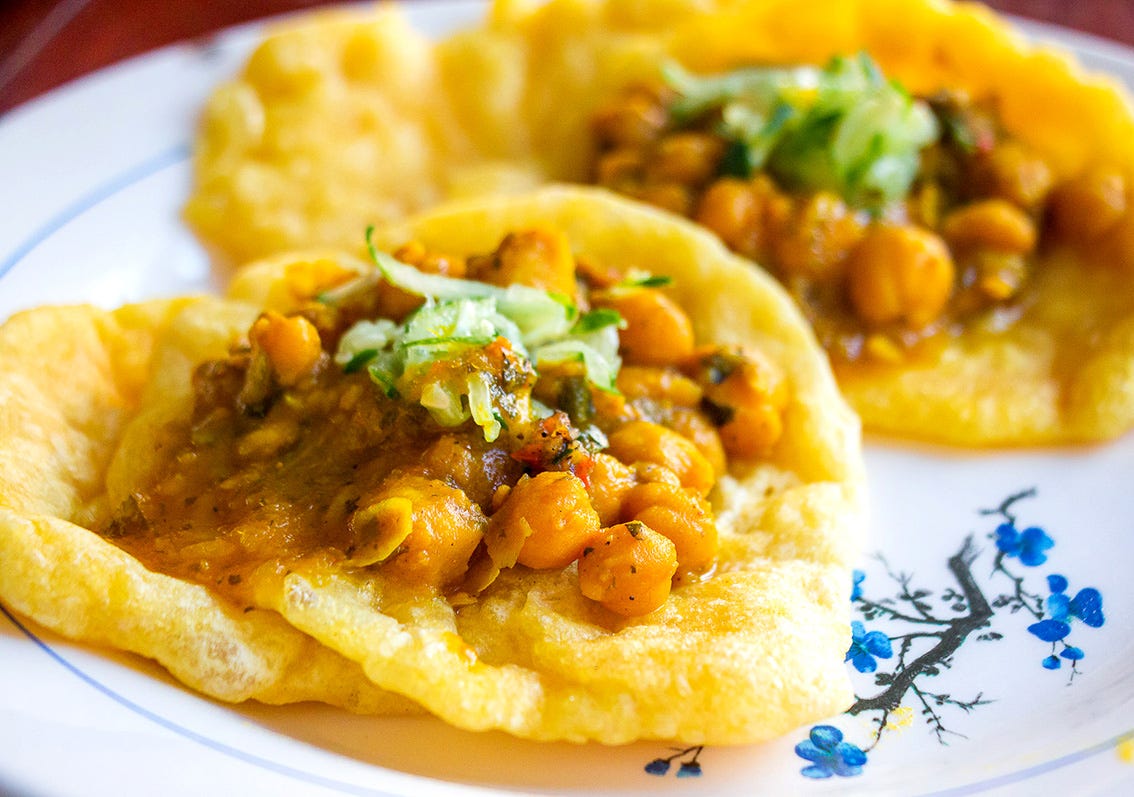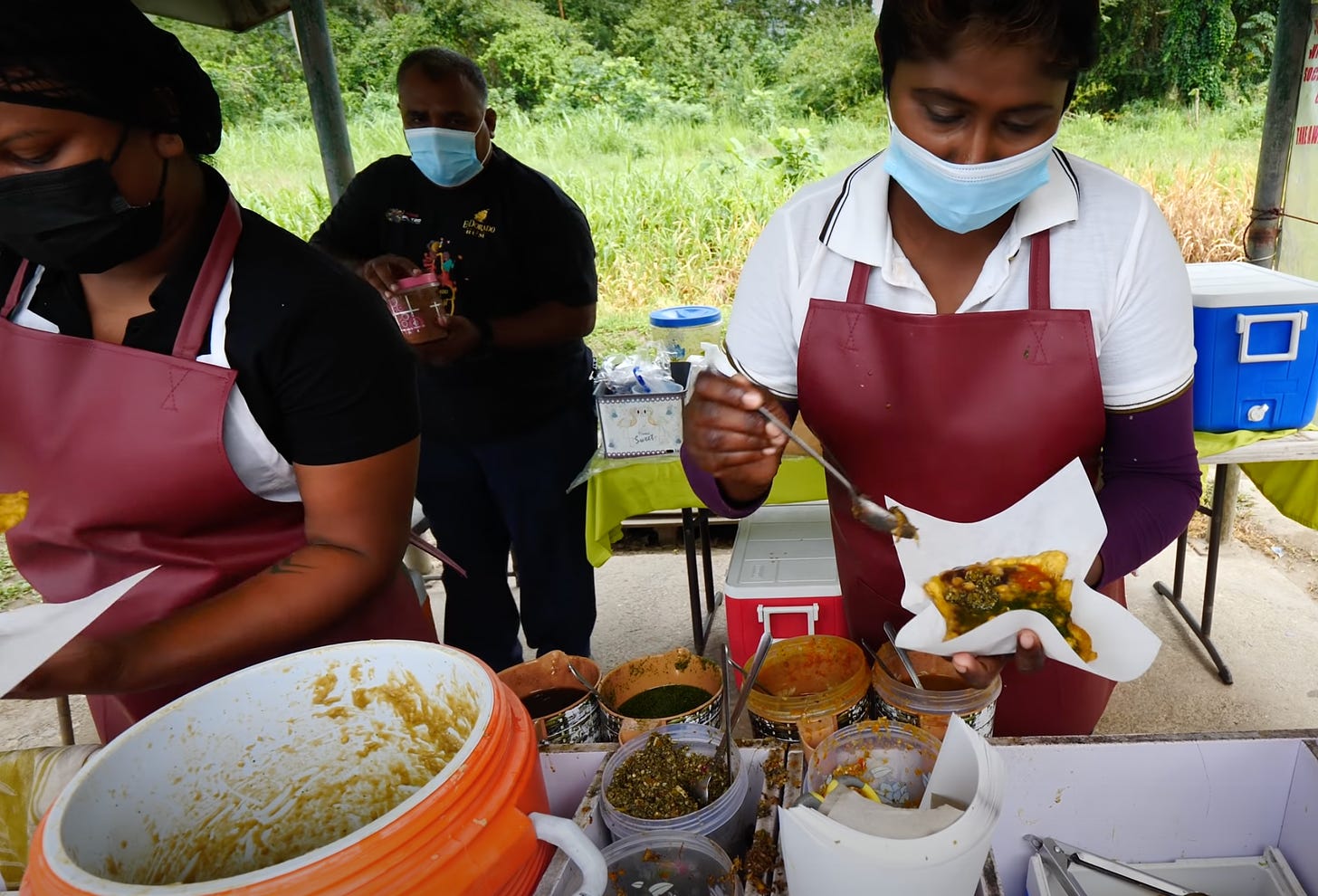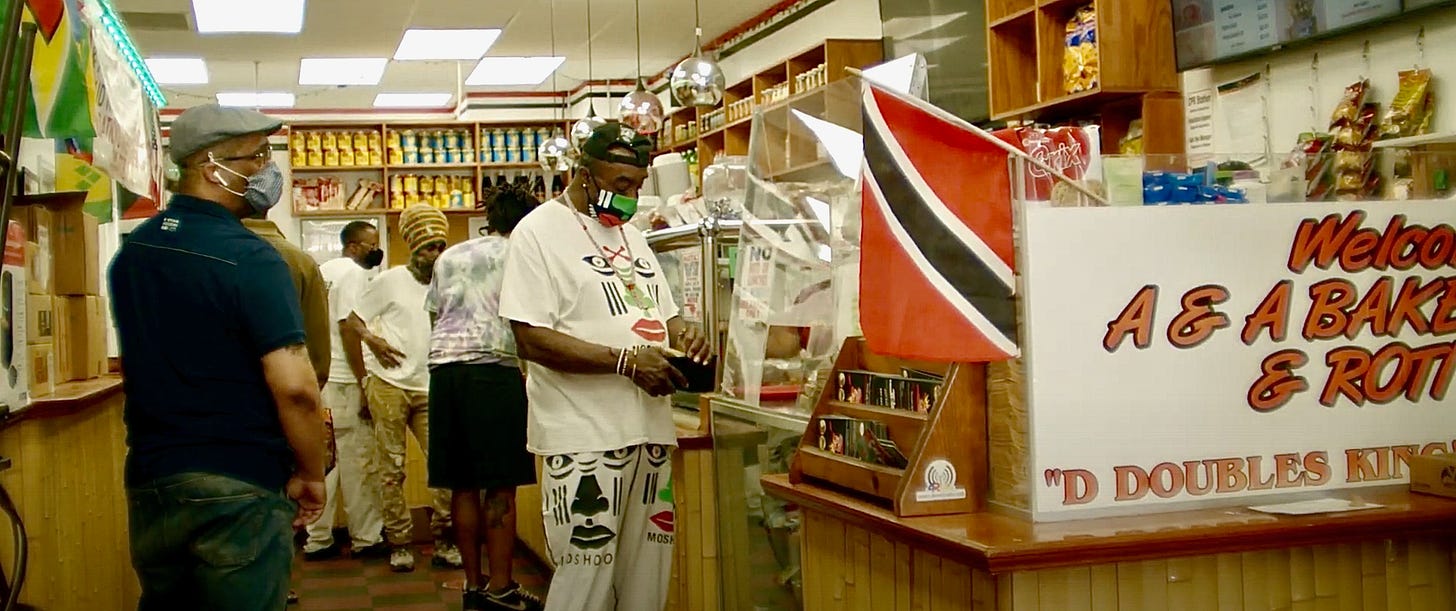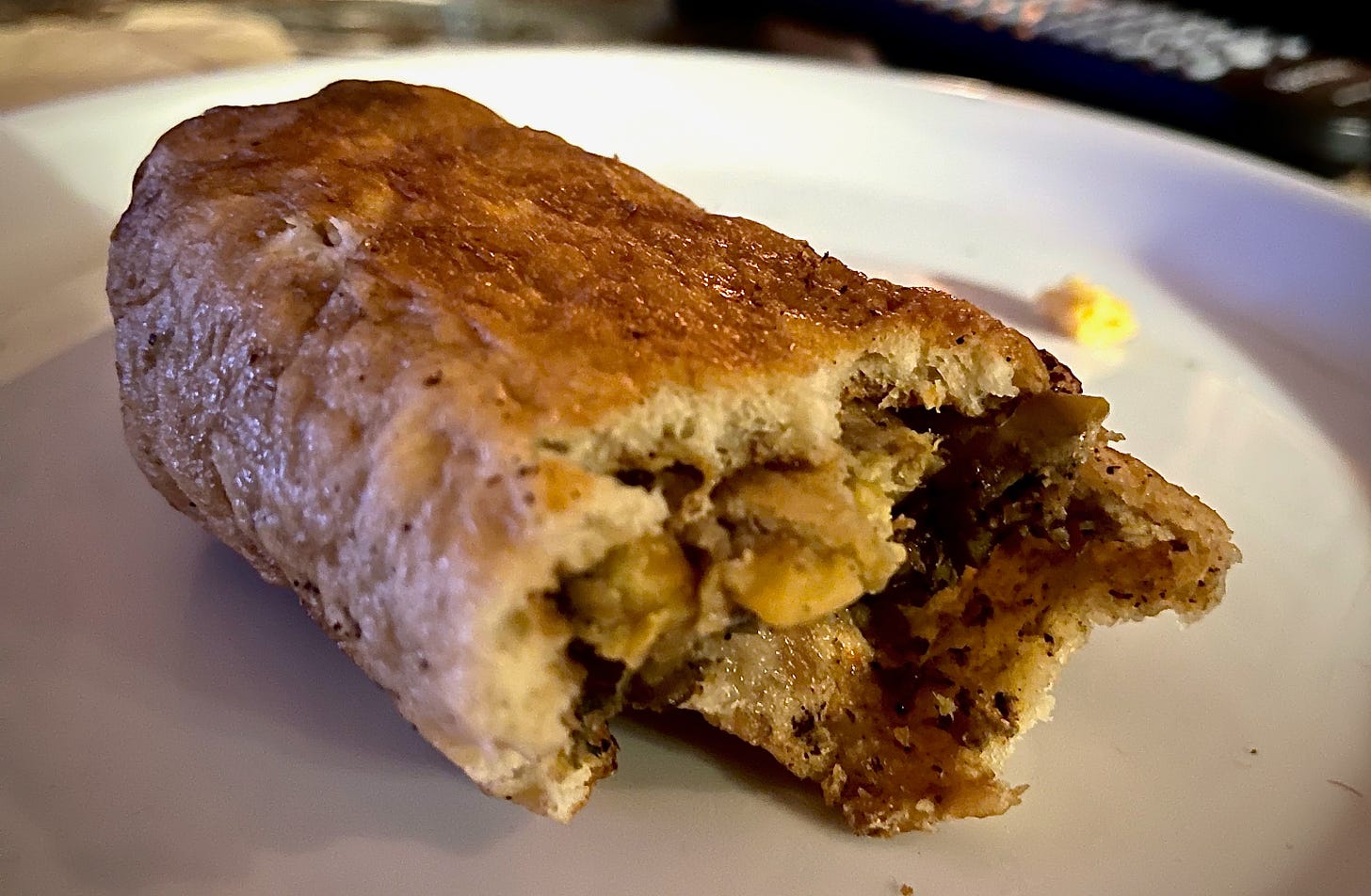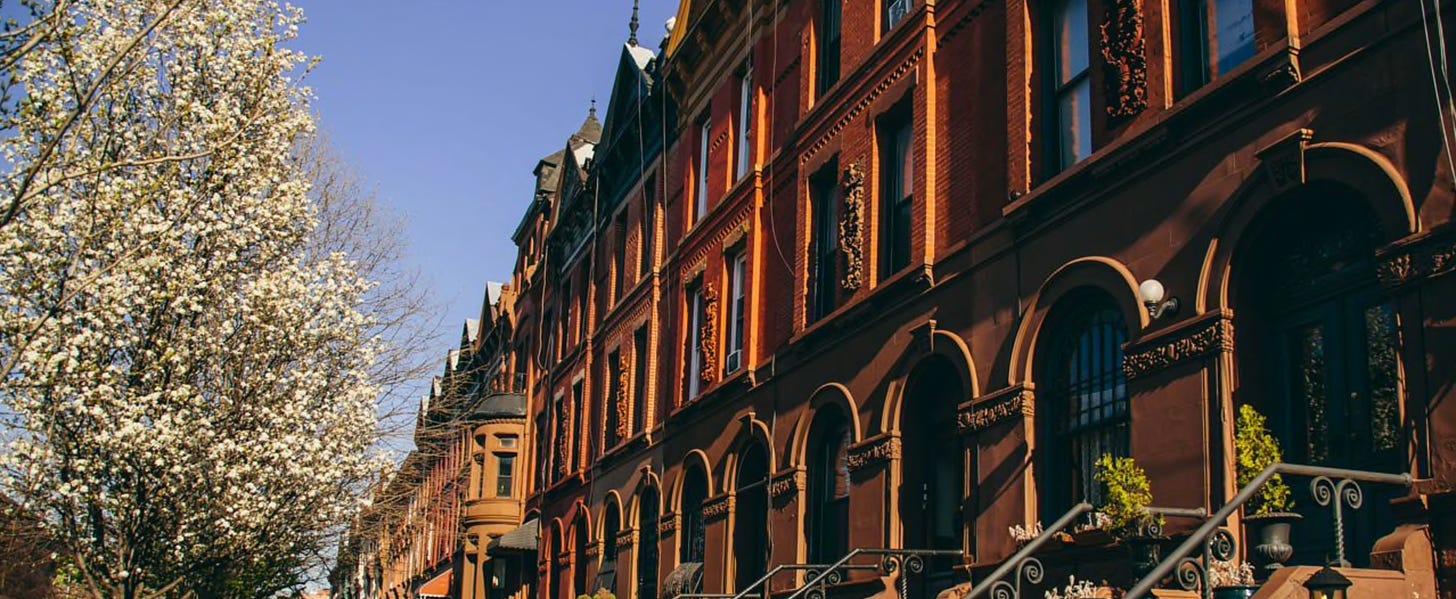Notable Sandwiches #59: Doubles
A Trinidadian staple, and a worthy emblem of New York in 2023
Welcome to the latest installment of Notable Sandwiches, where Talia and I trip merrily through the bizarre document that is Wikipedia’s List of Notable Sandwiches in alphabetical order. This week: Trinidad’s national dish—doubles.
One of my earliest, most vivid food memories is of an Indo-Trinadian wedding reception I attended when I was around five years old. The previous year my family had moved to a third-floor apartment on the grounds of Grace Church in Greenwich Village, New York, where my father worked. Much of the staff were Trinidadian immigrants of Indian descent, including the church’s head sexton, who invited my family to his daughter’s wedding. As anyone who has attended an Indian wedding will know, it was an extravagant affair, unlike any I’d experienced in my young life—and, as the son of a priest, I went to a lot more weddings than most kids. The music, dress, and dancing were all a dream, but what really lingers in my memory are the smells and tastes: strange chutneys, exotic spices, fragrant curries. I was already an adventurous eater, but this meal taught me that the reward for taking a risk and trying something new could be mind-expanding and life altering.
As a kid growing up in eighties New York, pluralism was arguably the defining factor in my world. The staff and congregation at Grace came from all over America and the globe. My classmates were mostly first generation Americans whose parents immigrated from Italy, Thailand, Poland, Tokyo, Turkey, the Philippines, and more. New York was a lot dirtier and more dangerous than it is now, but the city was still the polyglot stew of cultures and subcultures that I would come to cherish as an adult.
I honestly don’t remember if doubles were on the menu at that wedding reception; it’s possible. The origins of the dish can be traced back to Trinidad’s Indian community, who brought a variety of spices and cooking techniques when they immigrated to the Caribbean in the 19th and early 20th centuries. Allegedly invented in the early 70’s, “doubles” consists of two small, fried flatbreads—bara—arranged like a Mastercard logo and wrapped around a spicy filling of curried chickpeas—channa. Today they are consumed all over Trinidad by all walks of life, with vendors doctoring their signature recipes with tamarind, mango chutney, hot pepper, and turmeric: Indian flavors put to new uses in the New World.
The Sword and the Sandwich is a newsletter about serious extremism and equally serious sandwiches. Please consider supporting this work with a paid subscription:
Despite my early introduction to Indo-Trinidadian culture, I wouldn’t definitively sample doubles until decades later, when a colleague insisted we get some from a vendor near our office in midtown Manhattan. Having gone to college in the U.K., where late-night curries were a ubiquitous university staple, and having lived briefly in Nepal, which allowed for travel into neighboring India, I was reasonably familiar with South Asian cuisine. But this was Indian food filtered through a Caribbean lens. In the 19th century, millions of South Asians fled brutal conditions in the British Raj, taking work as indentured servants in far-flung outposts of the Empire. That included Trinidad. And when those Indo-Trinidadians emigrated to New York, they brought their doubles with them.
So, on Monday morning, I set out to sample the offerings at A&A Bake & Doubles Shop, “a delicious reminder of the Bed-Stuy’s rich Caribbean history” according to the James Beard Foundation, which gave the restaurant its “American Classics Award” in 2019. That’s just one of a litany of accolades the restaurant has received since opening its doors in Brooklyn’s Bedford-Stuyvesant neighborhood—including a slot on Eater’s list of New York’s most “essential restaurants.”
Located on Fulton Street, in a humble storefront redolent with the welcoming aromas of Caribbean spice and warm dough, A&A has been serving up West Indian specialties since opening its doors in 2002. As a cricket match played silently on a flat-screen TV and reggae music rang out softly from the stereo, I paid for my order: $13 for one shrimp, one fish, and two plain doubles. Then I headed home to see if it was worth the fuss.
It was worth the fuss. Though the fish doubles were (was?) a bit sodden from the travel, they were still irresistible, with a melange of Caribbean flavors—the sea and the garden, curry and coconut, salt and sweetness and spice. I say “it” because I wouldn’t really describe doubles as a “sandwich”; they’re closer to a wrap or burrito—certainly less sandwich-y than the proverbial hot dog. But that’s no matter, because this tasted so, so good, and because my $13 order fed me for the rest of the day. While that first taste of fish doubles knocked my socks off, the shrimp doubles I reheated later was even better. And with all due respect to the utility pizza slice, at $2 an order, the plain doubles from A&A may be the best deal in town.
In fact, I couldn’t get enough of them, quite literally. I also thought there was something poetic about getting a double dose of doubles, so the next day I returned to A&A and got the same order as the day before. In the meantime, I’d been reading up on the Indian diaspora, Trinidadian culture, and the histories of Bed-Stuy and of West Indians in New York. While the second time around lacked the unexpected thrill of the first, I was in no way disappointed by this return engagement.
Over the course of the day, I followed Donald Trump’s arraignment, which was occurring not far away, as well as the elections in Chicago and Wisconsin, which were. And I watched “Do the Right Thing,” whose West Indian chorus—shout out Coconut Sid—forms part of the fabric of Spike Lee’s stylized ‘80s Brooklyn. It’s a cinematic masterpiece of Bed-Stuy multiculturalism, a perfect pairing as I ate the rest of my doubles, another masterpiece of Bed-Stuy multiculturalism.
And then I woke up on Wednesday to a manic episode, my first since going on a mood stabilizer and writing about my experience with bipolar disorder a few months ago. Needless to say, though late winter/early spring is when I’ve usually been hit by mania in the past, this was an unexpected development. The excitement from the day before—which really did feel like a good day for America—had seemingly overwhelmed my pharmaceutical defenses. Still, despite my frustration, I wasn’t especially concerned; certainly not enough to bring me down from my previous day’s high.
Yesterday—Thursday—started bright and clear, with the temperature steadily rising as the sun worked its way across Brooklyn, from East New York to Bay Ridge. There was rain forecast for later in the day, so I decided to take advantage of the weather and my mental illness and spend some more time discovering Bed-Stuy. I started out on my journey by listening to the audiobook of “Inglorious Empire: What the British Did to India,” by Shashi Tharoor, before switching to a playlist of New York hip hop, heavy on Bed-Stuy heroes Biggie, Jay-Z and Big Daddy Kane (with whom I once shared an epic dinner at a Mexican restaurant, but that’s another story from a different lifetime.) And I explored a neighborhood that I hardly knew, despite spending my childhood in New York and having lived in Brooklyn for several years.
Bed-Stuy is everything I love about the city, and what I’ve loved about it since I first tasted Indo-Trinidadian food forty years ago. So when I got to A&A bake shop and placed my now regular order with the now familiar servers, I felt at home. If Sal’s Famous Pizzeria represented New York’s volatile pluralism in the 1980s, when Bed-Stuy was burning and Donald Trump was a local punchline, A&A’s doubles feel like a worthy emblem of 2023’s Big Apple, when Bed-Stuy feels more like Sesame Street, and Donald Trump is a national disgrace.





